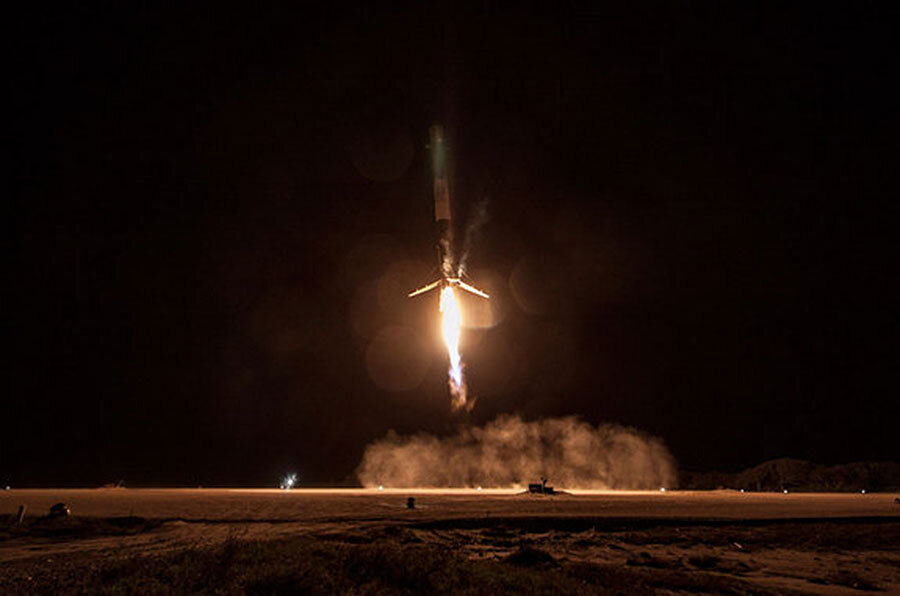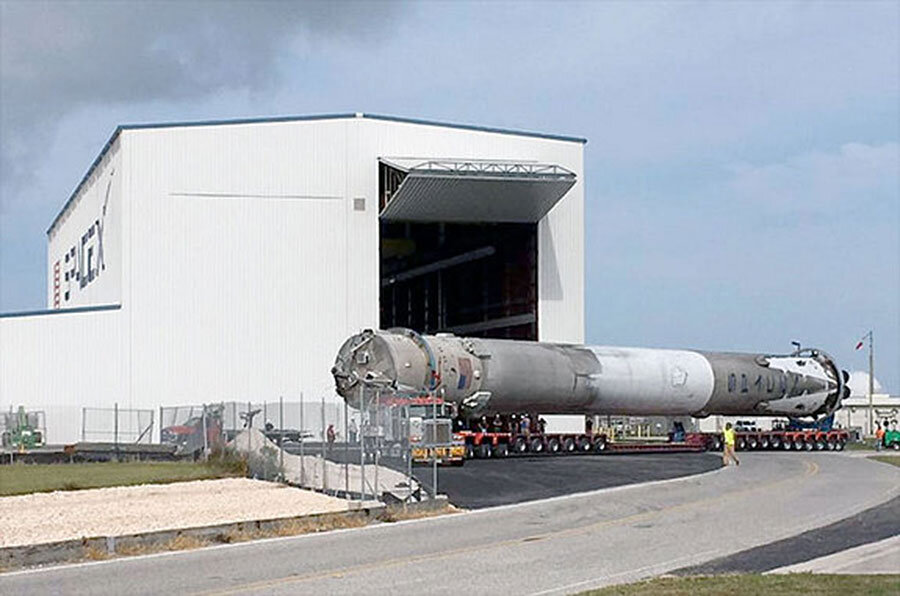SpaceX plans to preserve famed Falcon 9 rocket stage. But where?
Loading...
What do you do with a 15-story-tall space artifact?
That's a question that SpaceX now faces given the historic landing of its Falcon 9 rocket's first stage on Dec. 21 at the Cape Canaveral Air Force Station in Florida.
The commercial spaceflight company's recovery of the first stage, after launching 11 communication satellites to orbit, demonstrated the first part of its future plans for reusability. SpaceX intends to refurbish and re-fly its stages, ultimately getting to when it can simply refuel and launch them again, significantly reducing the cost of access to space. [See photos from SpaceX's Falcon 9 rocket landing]
But according to Elon Musk, SpaceX's billionaire CEO and chief technology officer, that's not the plan for this, its first-ever recovered stage.
"I think we will probably keep this one on the ground, just because it is kind of unique. It is the first one we brought back," explained Musk in a call with reporters.
Three days after it touched down on SpaceX's "Landing Zone 1," a converted Air Force launch pad, the stage was lowered onto its side and loaded onto a multi-wheeled flatbed for the short trip to NASA's Launch Complex 39A at the Kennedy Space Center. SpaceX is leasing the pad— the former site of Apollo and space shuttle launches — to begin flying astronauts aboard its Falcon 9 rockets topped with Dragon capsules to the International Space Station, as well as its commercial Falcon Heavy boosters.
On Thursday (Dec. 24), the recovered stage became the first tenant of SpaceX's new horizontal integration facility, a long hangar erected at the entrance to Pad 39A.
"[We will] do a static fire at the launch pad there, to confirm that all systems are good and that we are able to do a full thrust hold-down firing of the rocket," Musk said after the stage landed. The static fire will also test the modifications SpaceX has made to Pad 39A to support its rockets.
After that though, the stage will become a display piece.
"I think we will keep this one on the ground for tests that prove it could fly again and then put it somewhere — just because it is quite unique," Musk said.
But where is somewhere? SpaceX has yet to hint at, let alone perhaps decide, where the rocket stage may land for display. So in the absence of anything official, here are five suggestions where the Falcon 9 artifact might fit in.
The National Collection
When Musk unveiled his very first rocket, the Falcon 1, in December 2003, he trucked the seven-story-tall booster to Washington, D.C. and parked it outside the Smithsonian's National Air and Space Museum. So it would almost mimic the history made this month, returning to the "launch site," if the landed Falcon 9 stage was donated to the National Collection.
The Smithsonian does have an acquisition process and so it is not known if the institution would accept the stage, if offered by SpaceX. And there is the matter of "space" — the museum's main building on the National Mall is already rather full, so even if it wanted it, the stage might have to go to the institution's extension, the Steven F. Udvar-Hazy Center in northern Virginia, where it could be on display beside NASA's retired space shuttle Discovery.
But as the National Air and Space Museum displays the history of flight, a case could be made that the first orbital-class rocket to demonstrate vertical takeoff and landing would fit among the other aerospace artifacts it curates.
Launch Control
SpaceX's Mission Control is in California (see below), but its control center, where the Falcon 9 launch and landing was monitored and where Musk was present on that day, is located just outside the gate to the Cape Canaveral Air Force Station in Florida.
The one-story building is somewhat nondescript from the outside. What better way to say "SpaceX is here" than a 156-foot-tall (47.5 m) rocket stage standing vertically on its four landing legs?
The site also has the benefit of being publicly accessible. Located just next door to SpaceX is the Air Force Space and Missile History Center, an extension to the Air Force Space and Missile Museum located on base, where there is already a display dedicated to SpaceX's use of Launch Complex 40.
Rocket Garden
Outdoor displays do have their drawbacks, especially in Florida, where the ocean air can be corrosive to the metal skin of rockets and hurricanes can threaten to topple them over. But if SpaceX is okay with such an exhibit, then there is another potential place to park its stage on public view.
NASA's Kennedy Space Center Visitor Complex displays many of the boosters that made history at the Capein its Rocket Garden, including a Redstone rocket like the type used to launch the first American into space and one of the final Saturn IB boosters that began the first and last Apollo missions.
SpaceX's Falcon 9 will be among the next class of rockets to launch astronaut crews under a contract with NASA. If the space agency is amenable and SpaceX is willing, the Rocket Garden could be the perfect place for the stage's display.
Here be Dragons
But maybe SpaceX isn't ready to put the Falcon 9 stage on public show. Maybe when Musk said "somewhere," he was not referring to a museum or visitor center.
If so, then the landed stage could be stored where most of the company's recovered Dragon capsules used to deliver cargo to the space station are now held, at SpaceX's test facility in McGregor, Texas.
The closed-to-the-public test facility is located near Waco, between Dallas to the north and Austin to the south. It is also where SpaceX test flew its Grasshopper and Falcon 9 reusable development vehicles to work out how to land its stages before attempting to do it with operational rockets.
One Rocket Road
If Musk does want to display the stage where people can see it but not outside or in the public, then he could choose to place it where he did his company's first Dragon to fly to orbit and back.
Five years after it flew, the cargo capsule hangs from the ceiling of SpaceX's Headquarters in Hawthorne, California. The complex is also the production facility for the Dragon spacecraft and Falcon 9 boosters. As such, the recovered stage was assembled there, and, in theory, return there.
SpaceX protects access to its headquarters. Cameras are generally prohibited, even for those invited on tours inside, though the company did host the press there for the reveal of its Crew Dragon in 2014 and it was from there that the webcast for this month's launch and landing was staged.
And with a street address of 1 Rocket Road, SpaceX's HQ would certainly be an appropriate landing site for the first rocket the company recovered.
See a timelapse video of SpaceX’s recovered Falcon 9 first stage at collectSPACE.com.
Follow collectSPACE.com on Facebook and on Twitter at @collectSPACE. Copyright 2015 collectSPACE.com. All rights reserved.
- SpaceX Falcon Heavy To Be Reusable, Animation Reveals
- Inside SpaceX's Epic Fly-back Reusable Rocket Landing (Infographic)
- Reusable Rocket Launch Systems: How They Work (Infographic)
Copyright 2016 SPACE.com, a Purch company. All rights reserved. This material may not be published, broadcast, rewritten or redistributed.






